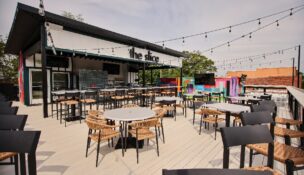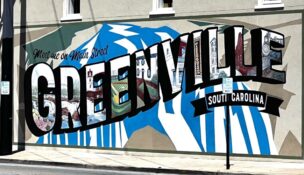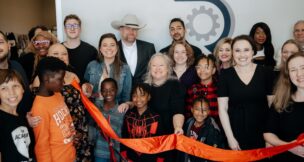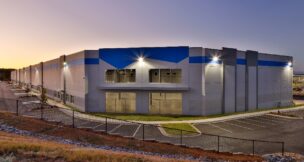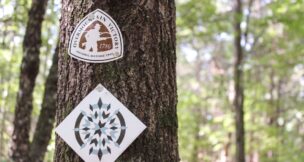Behind the record tourism numbers happening across the Upstate
Krys Merryman //November 3, 2023//
 Not only has South Carolina seen all-time high hospitality and tourism growth, but specifically the Upstate has witnessed a staggering economic impact locally in fiscal year 2023.
Not only has South Carolina seen all-time high hospitality and tourism growth, but specifically the Upstate has witnessed a staggering economic impact locally in fiscal year 2023.
From July 2022 through June 2023, approximately seven million people visited Greenville, spending $1.5 billion in hotels, restaurants, shops, and other local businesses — a record high.
Heath Dillard, president and CEO of VisitGreenvilleSC said, “When people show up here they realize it’s not just a great place to visit but also a great place to live and becomes an opportunity to attract talent in a wide variety of spaces. A great place to live is a great place to work and when we have a great place to work it’s a place that businesses will have to be. If it’s a place that businesses have to be, that will generate travel and tourism.”
When asked if he thinks Greenville is on track this year to surpass last year’s economic impact, Dillard said “absolutely.” Hotel room demand through August in Greenville County was 2.7 million rooms booked, which is a 3.9% increase from where the county was this time last year. To maintain this growth rate, the county would see about 105,000 more rooms sold by the end of 2023.
“For a market of this size, Greenville has incredible cultural aspects, great locally owned restaurants that are unique to the city,” said Dillard. “We have found is what people fall in love with here that differs from a city like New York is you still have all the excitement and energy but here you can get great art, food, great talent and acts in arenas and theaters without sacrificing its natural beauty. You have a slower pace, outdoor scenery, trails, hiking, and really get to experience nature in a way that’s hard to do in bigger cities.”
Greenville has fully recovered from pandemic
So, where does Dillard see Greenville’s tourism industry heading over the next decade?
Continued growth, he said.
While there are quite a few markets that are still recovering from the COVID-19 pandemic, said Dillard, Greenville has not only fully recovered but the economic impact has surpassed post-pandemic expectations by 29% — meaning more hotel rooms booked, restaurants, attractions, other types of shows and concerts, more amenities.
“We have seen visitors respond to that and continue to grow,” said Dillard. “Tourism is important to local communities when we have this visitor spending. Between all the taxes and revenue, the community really gets to invest in themselves in large part due by money spent by tourists.”
The more tourists are spending, the more amenities residents will get to enjoy in the future, he added.
“We get to experience a higher quality of life because of this cycle,” said Dillard.
Here are some data points from fiscal year 2023 shared by VisitGreenvilleSC:
- Accommodations tax revenue collected locally: $14.3M
- Hospitality tax revenue collected locally: $28.6M
- Tourism tax revenue generated: $42.9M
- 51,400 jobs in leisure and hospitality industry, nearly 1-in-9 jobs in the Upstate, which is up 8.4% year-over-year
- $29B an all-time high tourism industry impact in the state
- 213,000 engaged social media followers across all platforms | #yeahthatgreenville hashtag has been used more than 2.8M times on Instagram alone
“The role that tourism plays in a community is creating a sense of place,” said Dillard. “Greenville is stronger than it ever has been.”
What else is happening in the Upstate
City of Greer Tourism Specialist Lindsey Shaffer said Greer recently established its tourism division last summer, while Discover Greer serves as its tourism brand.
In 2019, the city renovated its downtown streetscape. Trade Street has pavers and streetlights, and even though these seem like minor changes, they set up the downtown as more of a destination, said Shaffer.
“We are focused on bringing people in through events and weddings,” said Shaffer. “But what changed a lot was this streetscape project, as we’ve seen an increase in visitors and hotel stays.”
Greer hosts more than 700 events a year in its rental facilities, whether its weddings, baby showers, or conferences.
“We continue on a controlled growth scale, being mindful to continue serving our residents but also welcome new visitors,” said Shaffer.
One thing the city is continuing to expand is its facilities to accommodate larger groups. The city purchased what was formerly Greer Country Club, which is now a public golf course, and they are working on renovating the club house and event space on that property, said Shaffer.
“Events such as our three-day international convention at city hall brings in a lot of people in commerce and business, which in turn helps us grow as a city,” said Shaffer. “Tier 3 manufacturers looking at Greer for its headquarters, and there needs to be things for them to do when they come in. So, in terms of tourism, we look back to that as a measure of the growth we have here.”
Upstate places emphasis on sports tourism growth
Sports tourism has been a main factor in the growth of the tourism industry in the Upstate. Spartanburg has more than 160 events annually, said Billy Dunlap, OneSpartanburg Inc.’s chief tourism development officer.
The Spartanburg City Council approved the first reading of a development agreement for a planned $425 million downtown baseball stadium development at its September meeting.
The project — known as Project Core — is a master plan for the next district of downtown Spartanburg. Combined with improvements underway along W. Main Street, according to the city, Project Core will transform the downtown’s western gateway, an area that has become increasingly attractive to mixed-use development.
The project will be “significant” to the economic development of the city moving forward, said Dunlap.
In addition to a 3,500-seat stadium, the development area will include 200,000 square feet of office space, more than 375 apartment units, a 150-room hotel, parking facilities to house at least 1,500 vehicles, and a large public plaza and event space. Construction on the project will take place in phases, with the stadium and first parking structure expected to be completed by spring of 2025 and subsequent phases to be completed over several years, according to the city of Spartanburg.
“The concept will be similar to Greenville’s West End,” said Dunlap. “I really think this development and Morgan Square will be the center of downtown when completed, the hub of activity for downtown. It’s a project that’s been years in the making, with a lot of partners involved in this project bringing this development here and could not be more excited for this to be open.”
Dunlap said the state was vital with support and funding for this project and can be seen as the “anchor” for downtown Spartanburg.
“It shows how important collaboration is when a city and county and state can all work together and work toward the same goal that will revolutionize downtown,” he added.
Some cities in the Upstate like Spartanburg’s growth have come with some challenges due to it being a historically small textile-driven town, said Dunlap.
“People that live in the Upstate, for some that’s still their impression of Spartanburg,” he added. “Through strong marketing efforts we are letting more people know what we have to offer, things to do, beautiful downtown area, great restaurants, arts scene, live music, murals, symphony, anything on the humanities side but changing the mindset has been a challenge.
“There has been an emphasis on getting people downtown so they really understand what the city has to offer. Although a challenge, it’s still a great opportunity to really showcase what we have to offer regardless of age and where you’re from.”
Like Spartanburg, Anderson has also directed its vision for the county on sports tourism. That includes the marketing, advertising, recruiting events as well as the continued development of facilities and the overall growth of the product to include more hotels, restaurants, attractions, etc., said Neil Paul, executive director of Visit Anderson.
Of that facility development, none have been more important than Green Pond Landing and Event Center on Lake Hartwell, he said.
“Lake Hartwell is arguable our greatest asset in Anderson County, and Green Pond Landing and Event Center has been the glue that put the community and the resource together,” said Paul.
Since opening in Dec. 2014, the economic impact of Green Pond Landing to the Upstate exceeds $100 million, as Green Pond Landing, Anderson County, and Visit Anderson have hosted local, regional, national, and international tournaments and events, he added.
The pandemic created a need for outdoor recreation and nature-based tourism, and Anderson County was among the few counties in the state to thrive during the pandemic from a tourism perspective, said Paul.
“Tourism has long been a powerful sector in the Upstate economic activity and growth, a positive trajectory for some time,” said Lauren Duffy, associate professor for the Clemson University Department of Parks, Recreation, and Tourism Management.
Taking a swing at sports tourism
Duffy also has noticed sports tourism being a significant trend in the Upstate, with the uptick in sporting events.
In addition to arts and culture events in Greenville like Fall for Greenville, the city’s biggest event of the year, Artisphere, and Euphoria, tournaments like Bassmaster and BMW Charity Pro-Am are becoming consistent within the region and continuing to become larger in attendance, said Duffy.
“Sports tourism at all levels has really taken off,” she added. “I think the intersection of tourism working with local parks and recs and being able to provide facilities that support that is crucial.”
For example, looking at minor league sports in mid-size markets often creates this unique community vibe, said Duffy.
“These events are a lot more accessible for families and young professionals,” she said. “And then people are going to restaurants right after or before the sporting events. They get people out on a Tuesday or Thursday evening. Even sports tournaments at the youth level such as baseball in Easley make a huge impact in these areas that otherwise don’t have minor league teams and such. As sports become more privatized, it makes a difference in smaller communities.”
Shaffer said Greer is looking more into the sports tourism sector also. For example, the city hosts rugby tournaments from seven states.
Duffy said at the end of the day when city officials make decisions around tourism development, residents need to be in mind and how they are impacted, their quality of life.
“When we lose sight of that for the sake of development, that’s when we price out locals and gentrification happen,” she added. “A lot of development in Greenville is now focused on affordable housing, and you have to approach tourism this way, to support the industry in the sense that the residents who work in the hospitality and tourism industry have to be able to afford to live where they work. It’s a balanced effort, and no matter the decisions that are made, your people must have a voice at the table.”
i









